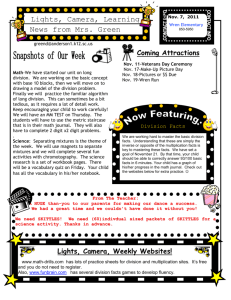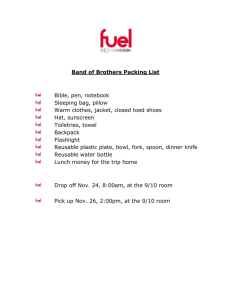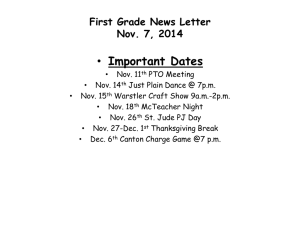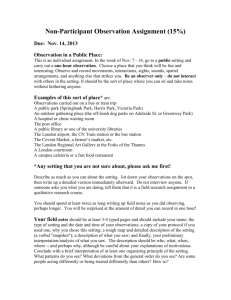Ecosystems Webquest
advertisement
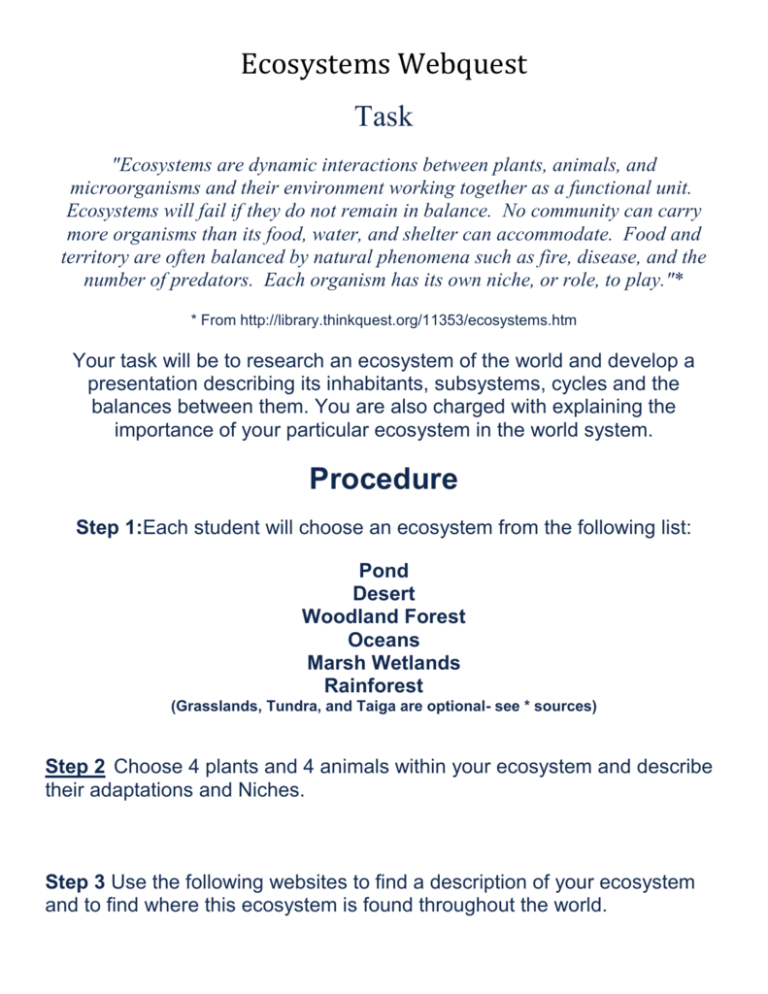
Ecosystems Webquest Task "Ecosystems are dynamic interactions between plants, animals, and microorganisms and their environment working together as a functional unit. Ecosystems will fail if they do not remain in balance. No community can carry more organisms than its food, water, and shelter can accommodate. Food and territory are often balanced by natural phenomena such as fire, disease, and the number of predators. Each organism has its own niche, or role, to play."* * From http://library.thinkquest.org/11353/ecosystems.htm Your task will be to research an ecosystem of the world and develop a presentation describing its inhabitants, subsystems, cycles and the balances between them. You are also charged with explaining the importance of your particular ecosystem in the world system. Procedure Step 1:Each student will choose an ecosystem from the following list: Pond Desert Woodland Forest Oceans Marsh Wetlands Rainforest (Grasslands, Tundra, and Taiga are optional- see * sources) Step 2 Choose 4 plants and 4 animals within your ecosystem and describe their adaptations and Niches. Step 3 Use the following websites to find a description of your ecosystem and to find where this ecosystem is found throughout the world. Resources Benders-Hyde, Elisabeth M. “Grasslands.” 14 Nov. 2007. <http://www.blueplanetbiomes.org/grasslands.htm> Benders-Hyde, Elisabeth M. “Taiga.” 14 Nov. 2007. <http://www.blueplanetbiomes.org/taiga.htm> Benders-Hyde, Elisabeth M. “Tundra.” 14 Nov. 2007. <http://www.blueplanetbiomes.org/tundra.htm> Missouri Botanical Garden. “Desert” 08 Nov. 2007. <http://www.mbgnet.net/sets/desert/index.htm> Missouri Botanical Garden. “Grasslands.” 14 Nov. 2007. <http://www.mbgnet.net/sets/grasslnd/index.htm > Missouri Botanical Garden. “Ponds And Lakes” 08 Nov. 2007. <http://www.mbgnet.net/fresh/lakes/index.htm> Missouri Botanical lGarden. “Rainforest” 08 Nov. 2007. <http://www.mbgnet.net/sets/rforest/index.htm> Missouri Botanical Garden. “Taiga.” 14 Nov. 2007. http://www.mbgnet.net/sets/taiga/index.htm Missouri Botanical Garden. “Temperate Deciduous Forests,” 08 Nov. 2007. <http://www.mbgnet.net/sets/temp/index.htm> Missouri Botanical Garden. “Temperate Oceans.” 08 Nov. 2007. <http://www.mbgnet.net/salt/oceans/index.htm Missouri Botanical Garden. “Tundra.” 14 Nov. 2007. <http://www.mbgnet.net/sets/tundra/index.htm> Missouri Botanical Garden. “Wetlands.” 08 Nov. 2007. <http://www.mbgnet.net/fresh/wetlands/index.htm> Windows to the Universe. “Oceans and Seas.” 08 Nov. 2007. < http://www.windows.ucar.edu/tour/link=/earth/Water/ocean.html&edu=elem>. Windows to the Universe. “Temperate Forest Ecosystem.” 08 Nov. 2007.< http://www.windows.ucar.edu/tour/link=/earth/forest_eco.html&edu=elem> Windows to the Universe. “The Desert Ecosystem.” 08 Nov. 2007. <http://www.windows.ucar.edu/tour/link=/earth/desert_eco.html&edu=elem> Windows to the Universe. “The Tropical Rainforest Ecosystem” 8 Nov. 2007.<http://www.windows.ucar.edu/tour/link=/earth/rainforest.html&edu=elem>. Step 4 Food Webs and Food Chains: Use the following websites and/or printed material to create both a food web and 2 food chains that can be found within your ecosystem. FOOD CHAIN WEBSITES Meng, Alan and Hui. “Food Chains and Webs.” 08 Nov. 2007. <http://www.vtaide.com/png/foodchains.htm> Science Bob. “Food Web and Food Chain.” 08 Nov. 2007. < http://www.sciencebob.com/lab/q-web-chain.html> Viau, Elizabeth Anne. “A Food Web in the Deciduous Forest Biome.” 08 Nov. 2007. <http://curriculum.calstatela.edu/courses/builders/lessons/less/biomes/ deciduous/de cweb.html> Viau, Elizabeth Anne. “Desert Food Web.” 08 Nov. 2007 < http://curriculum.calstatela.edu/courses/builders/lessons/less/ biomes/desert/hot-desertchain.html> Viau, Elizabeth Anne. “Rain Forest Food Web” 08 Nov. 2007 < http://curriculum.calstatela.edu/courses/builders/lessons/less/biomes/ rainforest/temp_rain/te mpweb.html> Ward, Paul. “Whales and Food Webs.” 08 Nov. 2007. http://www.coolantarctica.com/Antarctica%20fact%20file/wildlife/whales/ food%20we b.htm Waterwatch Adelaide. “Wetland Food Web.” 08 Nov. 2007. http://www.cwmb.sa.gov.au/KWC/section5/5-05.htm Step 5 Use the following websites and printed material to compare the life cycle of an animal and a plant within your ecosystem using a Venn Diagram. Enchanted Learning, “Growing and Changing.” 08 Nov. 2007. <http://www.enchantedlearning.com/books/general/growingchanging/> Enchanted Learning. “Life Cycles.” 08 Nov. 2007. <http://www.enchantedlearning.com/coloring/lifecycles.shtml> Fossweb. “Structures of Life.” 08 Nov. 2007. <http://www.fossweb.com/modules3-6/StructuresofLife/index.html> Growing Minds. “What is the Life Cycle of a Plant?” 08 Nov. 2007. <http://arboretum.fullerton.edu/grow/primer/cycle.asp> Kids Konnect. “Life Cycles.” 08 Nov. 2007. <http://www.kidskonnect.com/content/view/87/27/> MacKenzie, Paul. “Life Cycles.” 08 Nov. 2007. <http://elephant.elehost.com/About_Elephants/Life_Cycles/life_ cycles.html> Teams Educational Resources. “Cycles of Life.” 08 Nov. 2007. <http://teams.lacoe.edu/documentation/classrooms/judi/life/activities/cycles/life_cycles.html> Utah Education Network. “Life Cycles of Animals.” 08 Nov. 2007. <http://www.uen.org/themepark/cycles/animal.shtml> Enchanted Learning. "Deserts." 13 Nov. 2007. <http://www.enchantedlearning.com/biomes/desert/desert.shtml> Yarra Valley Water. “Life in a Pond.” 15 Nov. 2007. <http://www.yvw.com.au/waterschool/juniors.html> Step 6 – You will create a PowerPoint presentation to include all of the following: Adaptations and Niches Ecosystem Description and Cycles Comparison of life cycles of plants and animals Food Webs and Food Chains Your PowerPoint must include: A minimum of 6 slides. One slide must include why this ecosystem is important to us and the world's inhabitants. Pictures on all slides Automatic slide transitions Bibliography slide Use of SmartArt Graphics on at least one slide Background colors

